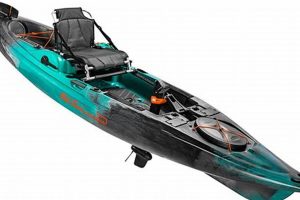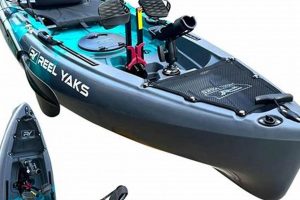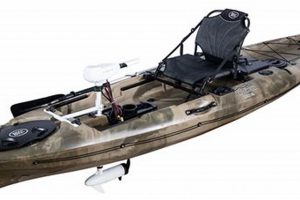These specialized vessels are designed for competitive anglers participating in organized fishing events. They prioritize features such as speed, stability, and ample storage for fishing gear and livewells. A typical example might include a lightweight hull for quick maneuvering, a comfortable seat for long hours on the water, and strategically placed rod holders and mounting points for fish finders and other electronics.
Competitive angling demands efficiency and effectiveness. Such craft provide a platform that allows participants to cover water quickly, access diverse fishing locations, and remain organized during intense competitions. This specialized design contributes significantly to an angler’s success by maximizing fishing time and minimizing wasted effort. The evolution of these watercraft reflects the growing sophistication and demands of tournament fishing, mirroring advancements in materials, design, and technology within the broader fishing industry.
Further exploration of this topic will delve into specific features, popular models, and strategies for selecting the optimal vessel for competitive fishing. Additionally, the discussion will encompass the role of these specialized boats in the broader context of tournament angling, conservation efforts, and the future of the sport.
Tips for Competitive Kayak Angling
Success in tournament fishing requires careful planning and execution. The following tips offer guidance for enhancing performance and maximizing potential in competitive kayak angling.
Tip 1: Stability is Key: Prioritize stability over speed. A stable platform allows for easier casting, fighting fish, and maneuvering in challenging conditions. Consider wider hulls or outriggers for enhanced stability.
Tip 2: Optimize Storage: Efficient organization is crucial. Utilize tackle boxes, trays, and specialized storage solutions designed for kayaks to maximize space and keep gear readily accessible.
Tip 3: Electronics Selection: Invest in high-quality fish finders and GPS units. Accurate readings and precise navigation are essential for locating fish and navigating efficiently during tournaments.
Tip 4: Practice Efficient Launching and Landing: Smooth transitions in and out of the water save valuable time. Practice launching and landing techniques to minimize delays and maximize fishing time.
Tip 5: Master Kayak Control: Proficient paddling and maneuvering skills are essential. Practice different paddling techniques to navigate efficiently in various conditions, including wind and current.
Tip 6: Pre-Fishing Scouting: Prioritize pre-fishing scouting trips to identify productive areas and patterns. This knowledge provides a significant advantage during competition.
Tip 7: Safety First: Always prioritize safety. Wear a personal flotation device, carry essential safety equipment, and be aware of weather conditions and potential hazards.
Implementing these strategies can significantly improve performance and contribute to competitive success. Careful preparation and efficient execution are vital for navigating the challenges of tournament kayak fishing.
By incorporating these tips, anglers can enhance their competitive edge and maximize their potential on the water. The following section will discuss additional strategies for tournament preparation and success.
1. Stability
Stability is a paramount consideration in tournament fishing kayaks, directly influencing an angler’s performance and safety. A stable platform is essential for effective casting, hooksets, and fighting fish, particularly in challenging conditions. This section explores the key facets contributing to stability in tournament fishing kayaks.
- Hull Design:
Hull design plays a critical role in kayak stability. Wider hulls generally offer greater initial stability, resisting tipping and providing a secure feeling. A flatter hull bottom enhances primary stability, while a more rounded or V-shaped hull may offer better secondary stability (resistance to capsizing once tilted). Pontoon-style hulls offer exceptional stability, favored by anglers prioritizing a rock-solid platform.
- Center of Gravity:
A lower center of gravity contributes significantly to stability. Sitting lower in the kayak and distributing weight evenly enhances balance and reduces the likelihood of tipping. Kayaks designed with recessed seating positions contribute to a lower center of gravity. Proper placement of gear and equipment also plays a crucial role in maintaining a balanced center of gravity.
- Water Conditions:
Prevailing water conditions significantly impact stability. Calm, flat water presents fewer challenges, while wind, waves, and currents demand greater stability from the kayak and the angler. Understanding how different hull designs perform in various conditions is crucial for tournament anglers. Anglers should choose kayaks appropriate for the anticipated water conditions.
- Angler Movement:
Angler movements, such as casting, retrieving, and landing fish, can compromise stability. Kayaks designed with ample deck space and strategically placed footrests allow anglers to shift weight and maintain balance while performing these actions. Practicing techniques for maintaining stability during various fishing activities is crucial.
The interplay of these factors determines the overall stability of a tournament fishing kayak. Selecting a kayak that balances stability with other essential performance characteristics, such as speed and maneuverability, is crucial for competitive success. Understanding the nuances of stability enhances angler confidence, safety, and effectiveness on the water.
2. Speed
Speed in a tournament fishing kayak directly influences an angler’s competitive edge. Rapidly reaching promising fishing locations, particularly in larger bodies of water, can significantly impact the outcome of a tournament. Consider a scenario where two anglers possess equal skill, but one utilizes a faster kayak. This angler can reach distant, potentially productive areas before competitors, increasing their chances of locating and catching fish early in the competition. This early advantage can translate into a higher overall catch and improved tournament standing. The ability to quickly relocate during changing conditions or in response to real-time information, such as fish movement detected on sonar, further underscores the value of speed. Efficient hull designs and lightweight materials contribute significantly to kayak speed, allowing anglers to maximize their time on the water effectively.
Different hull designs offer varying degrees of speed and maneuverability. Longer, narrower kayaks generally track better and achieve higher speeds, while shorter, wider kayaks offer enhanced stability but may sacrifice some speed. The selection of a kayak depends on the specific tournament environment and the angler’s priorities. For instance, in a large lake or reservoir, a longer, faster kayak might be advantageous. Conversely, in a smaller, more confined body of water with abundant structure, a shorter, more maneuverable kayak might prove more effective. The choice requires careful consideration of factors such as water conditions, fishing techniques, and personal preferences. Advances in kayak design, incorporating features like displacement hulls and optimized waterlines, continue to enhance speed without compromising stability.
Ultimately, speed must be considered in conjunction with other essential characteristics of a tournament fishing kayak, including stability, storage capacity, and comfort. Prioritizing speed alone may compromise stability and make it difficult to fish effectively, particularly in challenging conditions. The optimal approach involves selecting a kayak that balances speed with other key performance attributes to create a well-rounded and competitive fishing platform. Striking this balance empowers anglers to navigate the water efficiently, maximize their fishing time, and increase their chances of success in competitive angling environments. Continual advancements in kayak design and technology further refine this balance, providing anglers with increasingly sophisticated tools to pursue competitive success.
3. Storage Capacity
Storage capacity is a critical factor in tournament fishing kayaks, directly impacting an angler’s efficiency and preparedness. Effective organization and readily accessible gear are essential for maximizing fishing time and minimizing wasted effort during competitive events. Insufficient storage can lead to cluttered decks, hindering movement and potentially compromising stability. This section explores the key facets of storage capacity in tournament fishing kayaks.
- Tackle Organization:
Efficient tackle organization is paramount. Dedicated compartments and storage solutions designed specifically for fishing kayaks allow anglers to categorize lures, hooks, weights, and other essential gear. Quick access to specific items saves valuable time and allows anglers to adapt to changing conditions or fish behavior rapidly. Examples include specialized tackle boxes, trays with dividers, and customizable storage bags that fit securely within designated compartments. The ability to locate and deploy the right tackle quickly can be the difference between success and missed opportunities in a tournament setting.
- Rod Management:
Secure and accessible rod storage is essential. Tournament anglers often utilize multiple rods rigged with different lures or techniques. Rod holders, both flush-mounted and adjustable, keep rods organized and prevent entanglement. Easy access to rods allows for quick changes in strategy without disrupting the angler’s flow. Well-designed rod management systems contribute significantly to a streamlined and efficient fishing experience.
- Livewell Considerations:
Livewells, essential for maintaining the health and viability of caught fish during tournaments, occupy valuable space. The size and placement of the livewell influence the overall storage capacity and balance of the kayak. Anglers must consider the target species and tournament regulations when selecting an appropriate livewell system. Efficient livewell design minimizes space intrusion while maximizing the capacity to keep fish in optimal condition.
- Dry Storage:
Protecting essential gear from water damage is paramount. Dry storage compartments, often integrated into the kayak’s hull, safeguard electronics, phones, wallets, and other sensitive items. Properly sealed hatches and waterproof bags further enhance protection against splashes, rain, or accidental submersion. Ensuring the integrity of essential equipment contributes to a smooth and successful tournament experience.
These combined storage features contribute significantly to an angler’s efficiency and competitiveness on the water. A well-organized and easily accessible inventory of tackle, rods, and other essential gear allows for rapid adjustments and maximizes fishing time. Tournament anglers benefit from evaluating their specific needs and selecting a kayak with a storage system optimized for their fishing style and target species. By prioritizing efficient storage solutions, anglers enhance their preparedness and increase their likelihood of success in tournament environments.
4. Ergonomics
Ergonomics plays a crucial role in tournament fishing kayak design, significantly impacting angler performance and endurance. Prolonged periods on the water, often under strenuous conditions, demand a comfortable and supportive environment. A well-designed kayak minimizes fatigue, allowing anglers to maintain focus and effectiveness throughout the competition. Consider the impact of an uncomfortable seat on an angler’s ability to concentrate during a critical moment. Back pain, leg cramps, or simply general discomfort can distract from the task at hand and compromise performance. Conversely, a comfortable and ergonomic setup allows the angler to remain focused on fishing, maximizing their chances of success.
Key ergonomic considerations include seat design, adjustability, and the positioning of footrests and other key components. A well-designed seat provides ample support and cushioning, reducing pressure points and promoting proper posture. Adjustability allows anglers to customize the seat position and angle to suit their individual body types and preferences. Properly positioned footrests provide leverage for paddling and stability during casting and retrieving. For example, a kayak with a highly adjustable seat and strategically placed footrests can accommodate anglers of varying heights and builds, ensuring optimal comfort and support for each individual. This customization is crucial for maximizing long-term comfort and preventing fatigue during extended fishing sessions.
The practical significance of ergonomic design becomes evident during long tournament days. Reduced fatigue translates to improved concentration, faster reaction times, and more efficient performance. Anglers can maintain focus on critical tasks, such as identifying fish, making accurate casts, and effectively fighting and landing fish. Furthermore, ergonomic design minimizes the risk of physical strain and injury, promoting long-term angler health and well-being. The integration of ergonomic principles into tournament fishing kayak design reflects a growing understanding of the importance of angler comfort and its direct link to competitive success. Choosing a kayak with a strong emphasis on ergonomics represents a strategic investment in both performance and long-term angling enjoyment.
5. Maneuverability
Maneuverability in a tournament fishing kayak is paramount, directly influencing an angler’s ability to navigate complex environments and efficiently target fish. Precise boat control allows anglers to access tight spots, hold position in challenging currents, and respond quickly to changing fish behavior. This capability provides a distinct competitive advantage, enabling anglers to exploit opportunities that less maneuverable kayaks might miss. The following facets highlight the key components and implications of maneuverability in the context of tournament fishing.
- Hull Design and Length:
Hull design significantly impacts maneuverability. Shorter kayaks generally turn more quickly and require less effort to change direction, making them ideal for navigating tight quarters and complex shorelines. Longer kayaks, while potentially faster in open water, may be less responsive in confined areas. For example, a shorter kayak with a rounded hull can easily navigate through dense vegetation or around submerged structures, allowing anglers to access prime fishing locations inaccessible to longer, less maneuverable vessels.
- Paddle and Paddling Technique:
The paddle and paddling technique contribute significantly to maneuverability. A properly sized and shaped paddle, combined with efficient paddling strokes, allows for precise boat control and quick changes in direction. Techniques such as sweep strokes and reverse strokes enable rapid turns and adjustments in position. Mastering these techniques allows anglers to maintain precise boat control even in challenging conditions such as wind or current.
- Rudder or Skeg Systems:
Rudders and skegs enhance tracking and control, particularly in windy or current-prone environments. A rudder provides active control over steering, while a skeg improves directional stability. These systems allow anglers to maintain a desired course with less effort, conserving energy and enhancing overall efficiency. For instance, a rudder system enables precise adjustments to counteract wind drift, allowing the angler to maintain a desired casting position without constant paddling adjustments.
- Water Conditions:
Prevailing water conditions influence maneuverability. Calm, flat water generally presents fewer challenges, while wind, waves, and currents can significantly impact boat control. Understanding how different hull designs and control systems perform in various conditions is crucial for tournament anglers. Adapting paddling techniques and utilizing rudder or skeg systems effectively can mitigate the impact of challenging water conditions and maintain optimal maneuverability.
The interplay of these factors determines the overall maneuverability of a tournament fishing kayak. A highly maneuverable kayak empowers anglers to access a wider range of fishing locations, maintain precise boat control in challenging conditions, and respond quickly to changing fish behavior. This agility translates to increased fishing opportunities and a significant competitive edge in tournament settings. Choosing a kayak that balances maneuverability with other essential performance characteristics, such as stability and speed, is crucial for maximizing success on the water.
Frequently Asked Questions about Tournament Fishing Kayaks
This section addresses common inquiries regarding tournament fishing kayaks, providing concise and informative responses to assist anglers in making informed decisions.
Question 1: What differentiates a tournament fishing kayak from a recreational kayak?
Tournament fishing kayaks prioritize features essential for competitive angling, such as speed, stability, and specialized storage for fishing gear and livewells. Recreational kayaks, conversely, typically emphasize comfort and ease of use for casual paddling and exploration.
Question 2: How significant is stability in a tournament fishing kayak?
Stability is paramount. A stable platform enables effective casting, hooksets, and fish fighting, particularly in challenging conditions. Compromised stability can hinder performance and potentially create safety concerns.
Question 3: What role does speed play in tournament kayak fishing?
Speed allows anglers to reach promising fishing locations quickly, maximizing fishing time, especially in larger bodies of water. Rapid relocation enables efficient responses to changing conditions or fish movement.
Question 4: How crucial is storage capacity in a tournament fishing kayak?
Ample and organized storage is essential for efficient tackle management, rod storage, and maintaining the health of caught fish in a livewell. Streamlined organization maximizes fishing time and minimizes wasted effort.
Question 5: Why is ergonomics important in a tournament fishing kayak?
Ergonomics, encompassing seat comfort, adjustability, and footrest placement, minimizes fatigue during long hours on the water. Reduced fatigue enhances focus and performance, contributing directly to competitive success.
Question 6: How does maneuverability impact tournament fishing performance?
Precise boat control, enabled by efficient hull design and control systems, allows anglers to access tight spots, hold position in currents, and respond quickly to changing fish behavior. Enhanced maneuverability expands fishing opportunities and provides a competitive edge.
Understanding these key aspects of tournament fishing kayaks equips anglers with the knowledge necessary to select the appropriate vessel for their individual needs and competitive goals.
The following section will explore specific features and considerations for selecting a tournament fishing kayak.
Tournament Fishing Kayak
This exploration has highlighted the specialized nature of tournament fishing kayaks, emphasizing the critical interplay of stability, speed, storage, ergonomics, and maneuverability. These vessels represent a significant advancement in competitive angling, providing a platform optimized for efficiency, effectiveness, and endurance on the water. The selection process demands careful consideration of individual needs, fishing styles, and target environments. Understanding the nuances of each characteristic empowers anglers to make informed decisions that align with their competitive goals.
The evolution of tournament fishing kayaks reflects the continuous pursuit of enhanced performance and efficiency within the sport. As technology and design continue to advance, these specialized craft will undoubtedly play an increasingly crucial role in shaping the future of competitive angling. Strategic selection and effective utilization of these vessels will remain key determinants of success in the demanding arena of tournament fishing.






